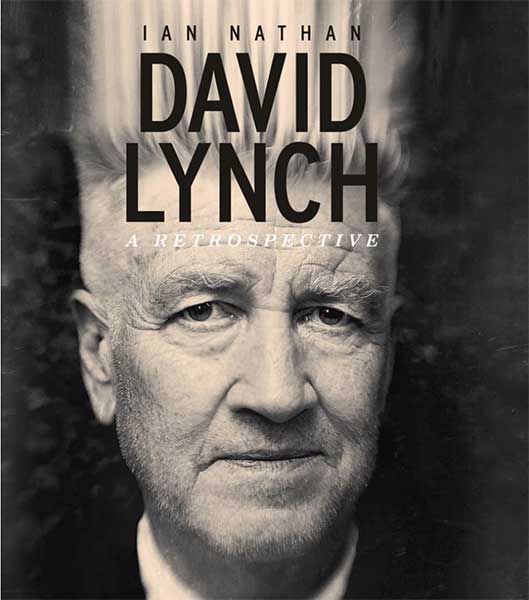
David Lynch. A Retrospective, Ian Nathan (Palazzo)
Ian Nathan claims that this ‘is not a book that sets out to unpick’ what he calls ‘the myriad mysteries’ in David Lynch’s films, but rather ‘a search for an understanding of that much used word, Lynchian’. Nathan also notes that ‘this book focusses on Lynch behind the camera, and only mentions the copious paintings, sculptures, photographic collections, commercials, stage productions and albums in passing’, which is a shame as these seem an important part of Lynch’s world view. And call me a cynic, but aren’t those mysteries the substance of being Lynchian?
Nathan, however, pursues a biographical and historical route rather than a critical one: we are told how films evolved, were scripted, shot and received rather than offered any cinematographic or critical insights. Nathan is apt to make dramatic declamations; in his chapter about Dune he notes that, despite the perceived failures of Lynch’s version, the film ‘still tells us so much about the director’, although Nathan resorts to telling the reader that ‘from the every start a cosmic aura pervaded [Lynch’s] films’ and that ‘[a]ll of them occupy worlds that are never quite normal, a Lynchian otherness seeps in, or bubbles up from below’, which hardly helps unpick what the word Lynchian actually means. Neither does his suggestion that we ‘think of [Dune] as an alien art project’.
More interesting is Nathan’s contention that ‘the failure of Dune was the making of Lynch’ and that
Twin Peaks was a demonstration – and a kind of redemption – that certain
stories should be allowed to swim and stretch in certain directions, without
the constrictions of theatrical showings, marketing departments and a
producer wearing a mask of smiles
although it will be another 20 pages before the reader comes to Twin Peaks.
Between Dune, which gradually seems to have become more accepted than it was at the time, and Twin Peaks, there was of course, Blue Velvet, which Nathan calls ‘the most provocative yet poetic examples of Lynch’s phantasmagorical America’, although he also notes that ‘Lynch still considers Blue Velvet his “most normal film.”‘ Nathan uses Lynch’s own ideas and that of critics to discuss whether Dennis Hopper’s character Frank is ‘not so much evil as twisted’, and how ‘part of the great appeal of Lynch is how personal his films feel to us’, not to mention the fact that ‘[t]here is a psychic intimacy between Lynch’s lack of self-consciousness and our secret psyches’. None of these ideas are unpicked further; for me, a David Foster Wallace quotation reproduced here is far more useful, where he notes that Lynch’s best movies ‘tend to derive a lot of their emotional power from their ability to make us feel complicit in their sickness’.
The first two series of Twin Peaks and the film Twin Peaks: Fire Walk With Me share a chapter, where once again Nathan resorts to talking around the film rather than about the film itself, repeating well known stories such as how Lynch spotted Frank Silva on set and created the demon BOB, and how Lynch was forced to reveal the killer well before he had planned. ‘If [Lynch] had had his way, the identity of the killer would have remained elusive for many seasons to come’, notes Nathan. Instead, once the audience were in the know, ‘[a]s Lynch foresaw, the air immediately went out of the strange balloon’ that he had created, and ‘[t]he audience awoke to the sensation that it was so much better wanting to know than knowing.’
Lynch also self-sabotaged his project by releasing a dark, horrific film that re-imagined the town of Twin Peaks as a much grittier and more sexualised place, alienating those – myself included – who had enjoyed the more surreal and homely elements of apple pie smalltown America rather than the occult violence in Fire Walk With Me. Twin Peaks: The Return, 25 years later, would go some way to reinstating the weird and puzzling a devoted audience, but in the meantime Lynch would make a number of strange movies – Wild At Heart, a debauched road trip; Lost Highway, a tale of murder and doppelgangers; Mulholland Drive, which explored the underbelly of wealthy Los Angeles; Inland Empire, which Nathan claims is ‘a multidimensional rabbit hole of altered states and alternative dimensions’ – and a quirky tale of tenacious individualism, Lawnmower Man.
What Nathan never does, despite his declaration that he will, is unpick what Lynchian is, in fact the book ends with the author excusing himself: ‘As to the true meaning of Lynchian? The mystery endures.’ True enough, but elsewhere critics and writers have tried harder to unpick the mechanics and meaning of Lynch’s ouevre, with attention to the sound design of the films and albums, the symbolism and meaning of the signs, props, locations and characters who populate Lynch’s world, not to mention the visual design elements of not only Lynch’s films but also his photographs and art works. They are all part of the same world that Lynch has created, and to ignore them in favour of summary, Hollywood stories and generalised assumptions feels like a cop-out. It is, of course, okay to ‘thrill to the unexpectedness’ of Lynch’s projects, perhaps even to accept that ‘we’re all living inside the dream’, but that doesn’t mean we can’t think about it, even in the beautifully produced coffee table world that this book inhabits.
.
Rupert Loydell
.
